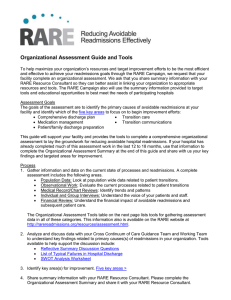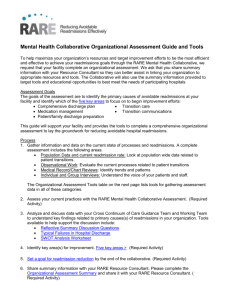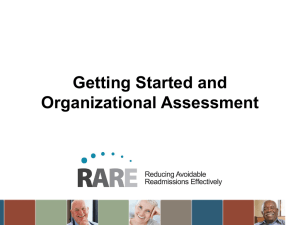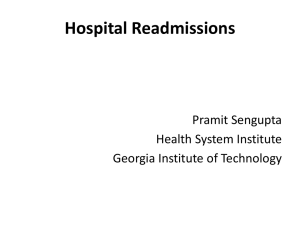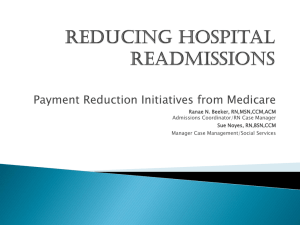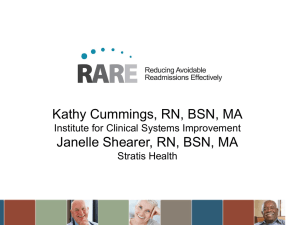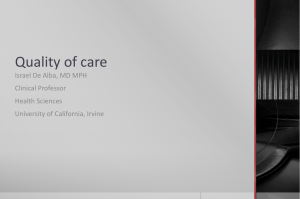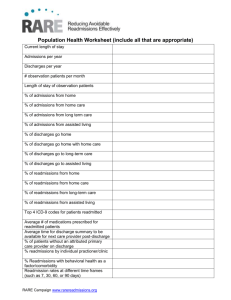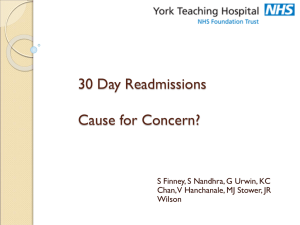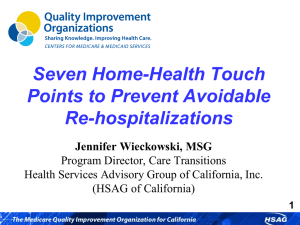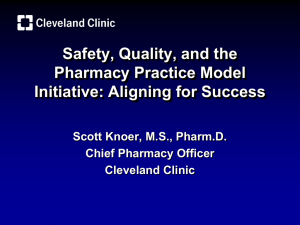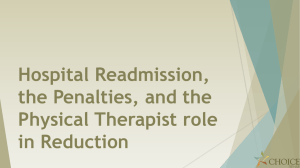Organizational Assessment Guide and Tools
advertisement
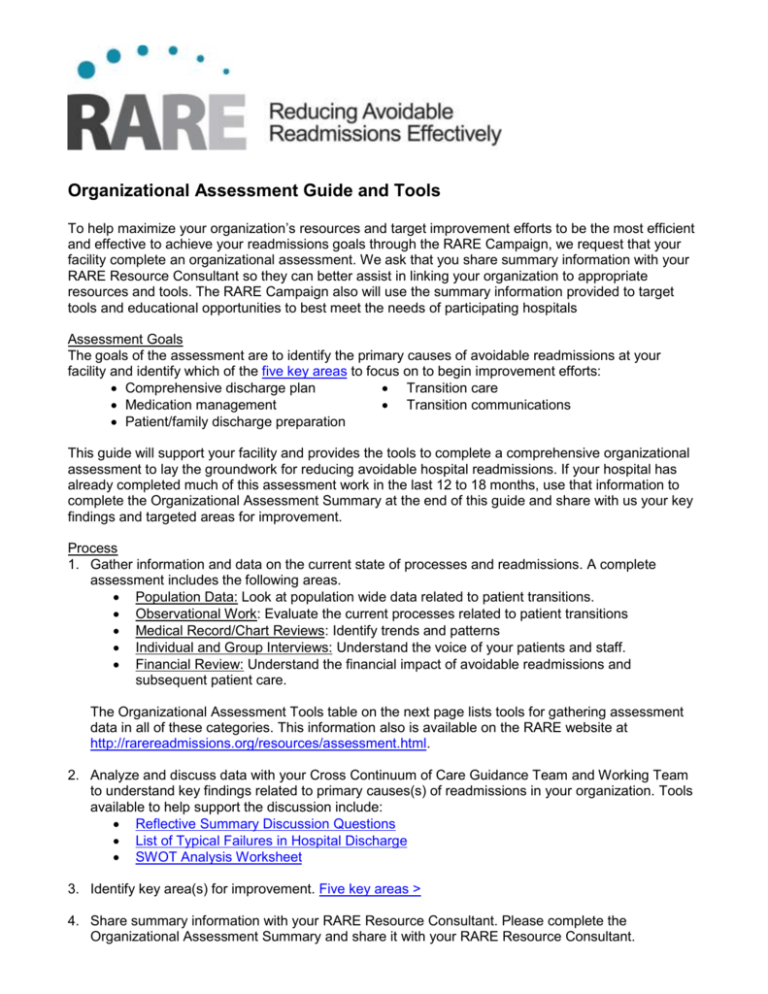
Organizational Assessment Guide and Tools To help maximize your organization’s resources and target improvement efforts to be the most efficient and effective to achieve your readmissions goals through the RARE Campaign, we request that your facility complete an organizational assessment. We ask that you share summary information with your RARE Resource Consultant so they can better assist in linking your organization to appropriate resources and tools. The RARE Campaign also will use the summary information provided to target tools and educational opportunities to best meet the needs of participating hospitals Assessment Goals The goals of the assessment are to identify the primary causes of avoidable readmissions at your facility and identify which of the five key areas to focus on to begin improvement efforts: Comprehensive discharge plan Transition care Medication management Transition communications Patient/family discharge preparation This guide will support your facility and provides the tools to complete a comprehensive organizational assessment to lay the groundwork for reducing avoidable hospital readmissions. If your hospital has already completed much of this assessment work in the last 12 to 18 months, use that information to complete the Organizational Assessment Summary at the end of this guide and share with us your key findings and targeted areas for improvement. Process 1. Gather information and data on the current state of processes and readmissions. A complete assessment includes the following areas. Population Data: Look at population wide data related to patient transitions. Observational Work: Evaluate the current processes related to patient transitions Medical Record/Chart Reviews: Identify trends and patterns Individual and Group Interviews: Understand the voice of your patients and staff. Financial Review: Understand the financial impact of avoidable readmissions and subsequent patient care. The Organizational Assessment Tools table on the next page lists tools for gathering assessment data in all of these categories. This information also is available on the RARE website at http://rarereadmissions.org/resources/assessment.html. 2. Analyze and discuss data with your Cross Continuum of Care Guidance Team and Working Team to understand key findings related to primary causes(s) of readmissions in your organization. Tools available to help support the discussion include: Reflective Summary Discussion Questions List of Typical Failures in Hospital Discharge SWOT Analysis Worksheet 3. Identify key area(s) for improvement. Five key areas > 4. Share summary information with your RARE Resource Consultant. Please complete the Organizational Assessment Summary and share it with your RARE Resource Consultant. Organizational Assessment Tools Component/Description Examples Population Data Look at population wide data related to patient transitions. Observational Work Evaluate the current processes related to patient transitions, asking questions such as: When are discharge summaries available to the next caregiver? How does that information get shared with the next caregiver? What is your process for medication reconciliation? How is it done? When is it done? Tools - Select tools that are most appropriate for your facility Admission/discharges per year and day Current hospital readmission rate Patient diagnosis Key characteristics of readmitted patients Length of stay Source of readmissions Common location of discharges Population Health Worksheet Complete a process map of hospital experience Observe an admission Observe patient teaching in preparation for discharge Observe a discharge Admission Assessment Observation Tool. Identify patients for observation during admission assessment and use this tool to discover the current process. (1-page Word doc) Understanding PPR Data Reports (Coming soon) Discharge Observation. Spend time observing a patient on the last day of stay. Discover what went well and what didn't work as planned and predicted. (1-page Word doc) Patient Teaching Observation Tool. Observe patient discharge teaching as it exists today. Honor the existing work and discover what went well. (1-page Word doc) Process Mapping/Value Stream Mapping. Understand how to use process mapping for quality improvement work. (19-page PDF) Component/Description Examples Observational Work continued Tools - Select tools that are most appropriate for your facility Cause and Effect Diagram (Fishbone). Includes a blank form for diagramming causes for readmissions, includes an example for preventing heart failure readmissions. (2-page PDF) 5 Whys Worksheet. Identify the root cause of your initial problem by completing this worksheet. (2-page PDF) Medical Record/Chart Reviews Identify trends and patterns. These reviews might include randomly sampled hospital discharges, reviews of 30-day readmissions, as well as reviews of other services provided such as skilled nursing, home health, or physician follow-up services. Individual and Group Interviews Review charts of at least 5 patients who were readmitted within 30 days for an unplanned readmission Work with partner organizations to review medical records of services provided by skilled nursing, home health or physician follow-up for the readmitted patients Understand the voice of your patients and staff. Individual interviews can help identify patterns, trends, and opportunities for improvement from the staff member and patient perspective. Group discussion and interviews allow for reflection and brainstorming of challenges and opportunities. Interview 4 to 5 patients or their families who have experienced an unplanned readmission within 30 days Interview the care team about what they observe as the main causes of hospital readmissions Complete a focus group with patients or care team Chart Review of Patients Who Were Readmitted. A simple chart review tool with audit information for up to five patients. (1-page Word doc) Care Transitions Abstraction Template. This abstraction helps review care transitions. (4-page Word doc) Hospital Readmission Review. This review worksheet helps identify potential readmission factors, covering nine categories of potential readmission factors. (2-page Word doc) Interviews with Patients, Family Members, and Care Team Members. Use this form to gather input from patients, family members and care team members then outline the circumstances that contributed to the readmission. (2-page Word doc) Readmission Worksheet. Use to identify gaps in care Divided into several sections obtaining feedback from the patient and the provider as well as minimal chart review. (3-page Word doc) Component/Description Financial Review Understand the financial impact of avoidable readmissions and subsequent patient care. Examples Determine what would be the consequences if your Medicare reimbursement for all patients was reduced by 0.5%, 1%, 2% or 3% Tools - Select tools that are most appropriate for your facility Return On Investment (ROI) Analysis and Calculator. The Project BOOST calculator helps you understand the financial impact of reducing readmissions at your hospital. The analysis document explains how to use the calculator and the algorithm behind the calculations, taking into account the hospital data, existing conditions, and actual or expected results from your project. Enter information specific to your hospital to compute the financial impact for your hospital. (7-page PDF and an Excel file) STAAR Financial Impact Diagnostic Tool. A 10-step tool to assess financial impact of readmissions. (1-page Word doc) Organizational Assessment Summary Organization: Team Lead: Team Members: Component Population Data Activities Completed Observational Work Medical Record/ Chart Reviews Individual and Group Interviews Financial Review Describe your organization’s priority areas for improvement using key findings identified. Tools: Questions for Reflective Team Discussion Typical Failures in Hospital Discharge Planning SWOT Analysis Worksheet Key Findings Focus Areas for Your Hospital Prioritize the five key areas of focus for your hospital (mark 1 through 5, with 1 being the highest priority). Definitions of key areas > ____ Comprehensive discharge plan ____ Medication management ____ Patient/family discharge preparation ____ Transition care ____ Transition communications Based on your organization’s priority areas, what types of tools and resources would be most helpful to assist your improvement efforts: Please share a copy of your completed RARE Organizational Assessment Summary with your RARE Resource Consultant so they can better assist and support your team’s efforts. RARE Campaign www.rarereadmissions.org
